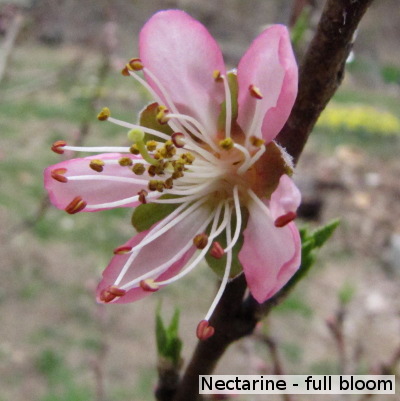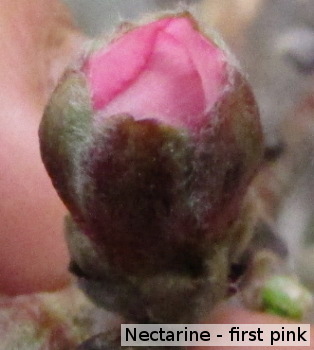
Fruit tree critical temperatures

 Have you ever heard the term
"nipped in the bud"? That's precisely what we hope won't happen
to our baby peaches, pears, and nectarines tonight, when the low is
forecast to be in the 20s. This is the one case where we're lucky
that we live on the shady side of the hill, since our fruit tree
flowers (mostly) haven't opened up yet, unlike the trees on our movie
star neighbor's farm, which are in full bloom.
Have you ever heard the term
"nipped in the bud"? That's precisely what we hope won't happen
to our baby peaches, pears, and nectarines tonight, when the low is
forecast to be in the 20s. This is the one case where we're lucky
that we live on the shady side of the hill, since our fruit tree
flowers (mostly) haven't opened up yet, unlike the trees on our movie
star neighbor's farm, which are in full bloom.
As a fruit tree bud
comes to life, it is less resistant to cold weather with every passing
day, and scientists have come up with charts of critical
temperatures,
telling us when we should kiss those summer peaches goodbye.
|
Apples |
Silver |
Green |
½
inch |
Tight |
First |
Full |
First |
Full |
Post
|
||||||||||||||
|
10%
kill |
15 |
18 |
23 |
27 |
28 |
28 |
28 |
29 |
29 |
||||||||||||||
|
Pears |
Bud
|
Bud |
Tight |
First |
Full |
First |
Full |
Post |
|||||||||||||||
|
10%
kill |
15 |
20 |
24 |
25 |
26 |
27 |
28 |
28 |
|||||||||||||||
|
Peaches |
Bud
|
Calyx |
Calyx |
First |
First |
Full |
Post |
||||||||||||||||
|
10%
kill |
18 |
21 |
23 |
25 |
26 |
27 |
28 |
||||||||||||||||
|
European |
Bud
|
Side |
Tip |
Tight |
First |
First |
Full |
Post |
|||||||||||||||
|
10%
kill |
14 |
17 |
20 |
24 |
26 |
27 |
28 |
28 |
|||||||||||||||
|
Sweet |
Bud
|
Side |
Green |
Tight |
Open |
First |
First |
Full |
Post |
||||||||||||||
|
10%
kill |
17 |
22 |
25 |
26 |
27 |
27 |
28 |
28 |
28 |
||||||||||||||
|
Tart |
Bud
|
Side |
Green |
Tight |
Open |
First |
First |
Full |
|||||||||||||||
|
10%
kill |
15 |
24 |
26 |
26 |
28 |
28 |
28 |
28 |
|||||||||||||||
 You can probably guess what
stage your fruit trees are at just based on the descriptions, but I've
included some photos here to help you decipher the differences.
Our peach trees are in the red calyx stage (10% kill at 23 degrees and
90% kill at 9 degrees), our pears are in the first white to full white
stage (10% kill at 25 to 26, 90% kill at 19 to 22), and our nectarine
has buds ranging from red calyx to full bloom (10% kill at 23 to 27,
90% kill at 9 to 24 degrees.)
You can probably guess what
stage your fruit trees are at just based on the descriptions, but I've
included some photos here to help you decipher the differences.
Our peach trees are in the red calyx stage (10% kill at 23 degrees and
90% kill at 9 degrees), our pears are in the first white to full white
stage (10% kill at 25 to 26, 90% kill at 19 to 22), and our nectarine
has buds ranging from red calyx to full bloom (10% kill at 23 to 27,
90% kill at 9 to 24 degrees.)As you can see, you often find an array of bud stages on a single tree, which is good for us because it means that a late frost is less likely to kill off all of our fruit. Even though the currently open nectarine buds and
 nearly open pear buds are probably going to die tonight, the less
precocious buds on each tree might pull through, and I'm not overly
concerned about our peach buds.
nearly open pear buds are probably going to die tonight, the less
precocious buds on each tree might pull through, and I'm not overly
concerned about our peach buds.All of that said, I'm not sure I expect pears this year. Although my sample size is very small, I've found that each of my fruit trees has produced flowers but no fruit the first year it blooms. Perhaps the trees aren't quite ready to pour that much energy into making fruits but are willing to make flowers in hopes that their pollen might pass on the tree's genes using someone else's energy budget? I'd be curious to hear if you've seen a similar strategy in your own young fruit trees. If my hypothesis is correct, we should see peaches from the tree that fruited last year and also from the tree that only bloomed last year, nectarines from the tree that bloomed last year, but no pears. Assuming we don't get any excessively cold weather in the next few weeks, that is....
Want more in-depth information? Browse through our books.
Or explore more posts by date or by subject.
About us: Anna Hess and Mark Hamilton spent over a decade living self-sufficiently in the mountains of Virginia before moving north to start over from scratch in the foothills of Ohio. They've experimented with permaculture, no-till gardening, trailersteading, home-based microbusinesses and much more, writing about their adventures in both blogs and books.
Want to be notified when new comments are posted on this page? Click on the RSS button after you add a comment to subscribe to the comment feed, or simply check the box beside "email replies to me" while writing your comment.
